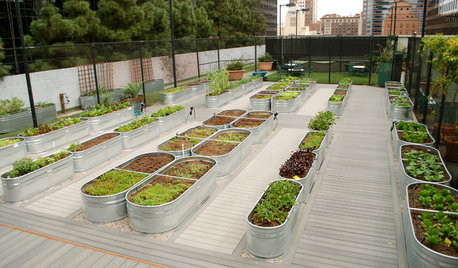Don't like the look of edible landscaping/ lawn alternatives?
melandrew
15 years ago
Related Stories

MOST POPULARMeet a Lawn Alternative That Works Wonders
Carex can replace turfgrass in any spot, is low maintenance and adjusts easily. Add its good looks and you’ve got a ground cover winner
Full Story
LANDSCAPE DESIGN7 Low-Maintenance Lawn Alternatives
Turf isn't the only ground cover in town. Get a lush no-grass lawn with clover, moss and other easy-care plants
Full Story
EARTH DAYThe Case for Losing the Traditional Lawn
Work less, help the environment and foster connections by just saying no to typical turf
Full Story
BEFORE AND AFTERSSee 6 Yards Transformed by Losing Their Lawns
Wondering whether a turf lawn is the best use of your outdoor space? These homeowners did, and they found creative alternatives
Full Story
LANDSCAPE DESIGN15 Great Ideas for a Lawn-Free Yard
End the turf war for good with hardscaping, native grasses and ground covers that save water and are easier to maintain
Full Story
LANDSCAPE DESIGNGet Along With Less Lawn — Ideas to Save Water and Effort
Ditch the mower and lower your water bill while creating a feast for the eyes with diverse plantings and gathering places
Full Story
FRONT YARD IDEAS10 Ideas for a Front-Yard Edible Garden Your Neighbors Will Love
Choosing attractive, well-mannered plants and sharing the bounty will go a long way toward keeping the peace
Full Story
LANDSCAPE DESIGNRecipe for Modernist Edible Garden Style
Herbs, vegetables and fruit trees aren’t just for traditional gardens. Here’s how to design them into modernist landscapes
Full Story
LANDSCAPE DESIGNCalifornia Says Goodbye to the Sprawling Ornamental Lawn
New state rules will effectively limit turfgrass to 25 percent of the landscape in most new and renovated yards
Full Story
GREAT HOME PROJECTSHow to Replace Your Lawn With a Garden
New project for a new year: Lose the turfgrass for energy savings, wildlife friendliness and lower maintenance
Full Story







laag
timbu
Related Discussions
some lawn alternatives and other landscaping ideas
Q
Okay, I'll say it - I just don't like ground cover...
Q
landscape rock and gardens don't mix...
Q
Wow - I don't like my new Kindle!
Q
gardengal48 (PNW Z8/9)
rhodium
karinl
barefootinct
karinl
Embothrium
gardengal48 (PNW Z8/9)
mad_gallica (z5 Eastern NY)
Embothrium
isabella__MA
laag
gardengal48 (PNW Z8/9)
trancegemini_wa
Bumblebeez SC Zone 7
mohavemaria
trancegemini_wa
isabella__MA
mohavemaria
laag
linda_daisy
mjsee
lpinkmountain
Embothrium
lpinkmountain